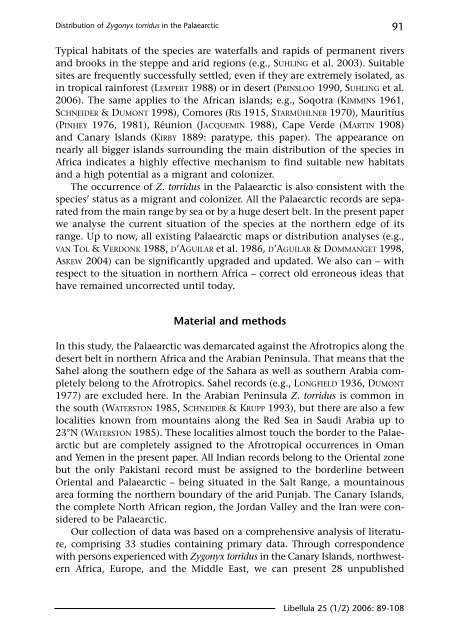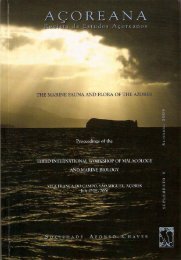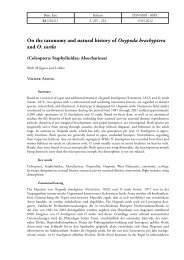The distribution of Zygonyx torridus in the Palaearctic (Odonata ...
The distribution of Zygonyx torridus in the Palaearctic (Odonata ...
The distribution of Zygonyx torridus in the Palaearctic (Odonata ...
You also want an ePaper? Increase the reach of your titles
YUMPU automatically turns print PDFs into web optimized ePapers that Google loves.
Distribution <strong>of</strong> <strong>Zygonyx</strong> <strong>torridus</strong> <strong>in</strong> <strong>the</strong> <strong>Palaearctic</strong> 91<br />
Typical habitats <strong>of</strong> <strong>the</strong> species are waterfalls and rapids <strong>of</strong> permanent rivers<br />
and brooks <strong>in</strong> <strong>the</strong> steppe and arid regions (e.g., SUHLING et al. 2003). Suitable<br />
sites are frequently successfully settled, even if <strong>the</strong>y are extremely isolated, as<br />
<strong>in</strong> tropical ra<strong>in</strong>forest (LEMPERT 1988) or <strong>in</strong> desert (PRINSLOO 1990, SUHLING et al.<br />
2006). <strong>The</strong> same applies to <strong>the</strong> African islands; e.g., Soqotra (KIMMINS 1961,<br />
SCHNEIDER & DUMONT 1998), Comores (RIS 1915, STARMÜHLNER 1970), Mauritius<br />
(PINHEY 1976, 1981), Réunion (JACQUEMIN 1988), Cape Verde (MARTIN 1908)<br />
and Canary Islands (KIRBY 1889: paratype, this paper). <strong>The</strong> appearance on<br />
nearly all bigger islands surround<strong>in</strong>g <strong>the</strong> ma<strong>in</strong> <strong>distribution</strong> <strong>of</strong> <strong>the</strong> species <strong>in</strong><br />
Africa <strong>in</strong>dicates a highly effective mechanism to f<strong>in</strong>d suitable new habitats<br />
and a high potential as a migrant and colonizer.<br />
<strong>The</strong> occurrence <strong>of</strong> Z. <strong>torridus</strong> <strong>in</strong> <strong>the</strong> <strong>Palaearctic</strong> is also consistent with <strong>the</strong><br />
species’ status as a migrant and colonizer. All <strong>the</strong> <strong>Palaearctic</strong> records are separated<br />
from <strong>the</strong> ma<strong>in</strong> range by sea or by a huge desert belt. In <strong>the</strong> present paper<br />
we analyse <strong>the</strong> current situation <strong>of</strong> <strong>the</strong> species at <strong>the</strong> nor<strong>the</strong>rn edge <strong>of</strong> its<br />
range. Up to now, all exist<strong>in</strong>g <strong>Palaearctic</strong> maps or <strong>distribution</strong> analyses (e.g.,<br />
VAN TOL & VERDONK 1988, D’AGUILAR et al. 1986, D’AGUILAR & DOMMANGET 1998,<br />
ASKEW 2004) can be significantly upgraded and updated. We also can – with<br />
respect to <strong>the</strong> situation <strong>in</strong> nor<strong>the</strong>rn Africa – correct old erroneous ideas that<br />
have rema<strong>in</strong>ed uncorrected until today.<br />
Material and methods<br />
In this study, <strong>the</strong> <strong>Palaearctic</strong> was demarcated aga<strong>in</strong>st <strong>the</strong> Afrotropics along <strong>the</strong><br />
desert belt <strong>in</strong> nor<strong>the</strong>rn Africa and <strong>the</strong> Arabian Pen<strong>in</strong>sula. That means that <strong>the</strong><br />
Sahel along <strong>the</strong> sou<strong>the</strong>rn edge <strong>of</strong> <strong>the</strong> Sahara as well as sou<strong>the</strong>rn Arabia completely<br />
belong to <strong>the</strong> Afrotropics. Sahel records (e.g., LONGFIELD 1936, DUMONT<br />
1977) are excluded here. In <strong>the</strong> Arabian Pen<strong>in</strong>sula Z. <strong>torridus</strong> is common <strong>in</strong><br />
<strong>the</strong> south (WATERSTON 1985, SCHNEIDER & KRUPP 1993), but <strong>the</strong>re are also a few<br />
localities known from mounta<strong>in</strong>s along <strong>the</strong> Red Sea <strong>in</strong> Saudi Arabia up to<br />
23°N (WATERSTON 1985). <strong>The</strong>se localities almost touch <strong>the</strong> border to <strong>the</strong> <strong>Palaearctic</strong><br />
but are completely assigned to <strong>the</strong> Afrotropical occurrences <strong>in</strong> Oman<br />
and Yemen <strong>in</strong> <strong>the</strong> present paper. All Indian records belong to <strong>the</strong> Oriental zone<br />
but <strong>the</strong> only Pakistani record must be assigned to <strong>the</strong> borderl<strong>in</strong>e between<br />
Oriental and <strong>Palaearctic</strong> – be<strong>in</strong>g situated <strong>in</strong> <strong>the</strong> Salt Range, a mounta<strong>in</strong>ous<br />
area form<strong>in</strong>g <strong>the</strong> nor<strong>the</strong>rn boundary <strong>of</strong> <strong>the</strong> arid Punjab. <strong>The</strong> Canary Islands,<br />
<strong>the</strong> complete North African region, <strong>the</strong> Jordan Valley and <strong>the</strong> Iran were considered<br />
to be <strong>Palaearctic</strong>.<br />
Our collection <strong>of</strong> data was based on a comprehensive analysis <strong>of</strong> literature,<br />
compris<strong>in</strong>g 33 studies conta<strong>in</strong><strong>in</strong>g primary data. Through correspondence<br />
with persons experienced with <strong>Zygonyx</strong> <strong>torridus</strong> <strong>in</strong> <strong>the</strong> Canary Islands, northwestern<br />
Africa, Europe, and <strong>the</strong> Middle East, we can present 28 unpublished<br />
Libellula 25 (1/2) 2006: 89-108
















